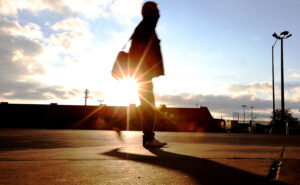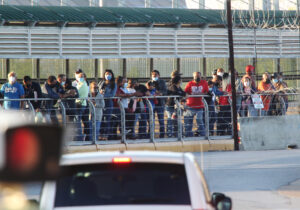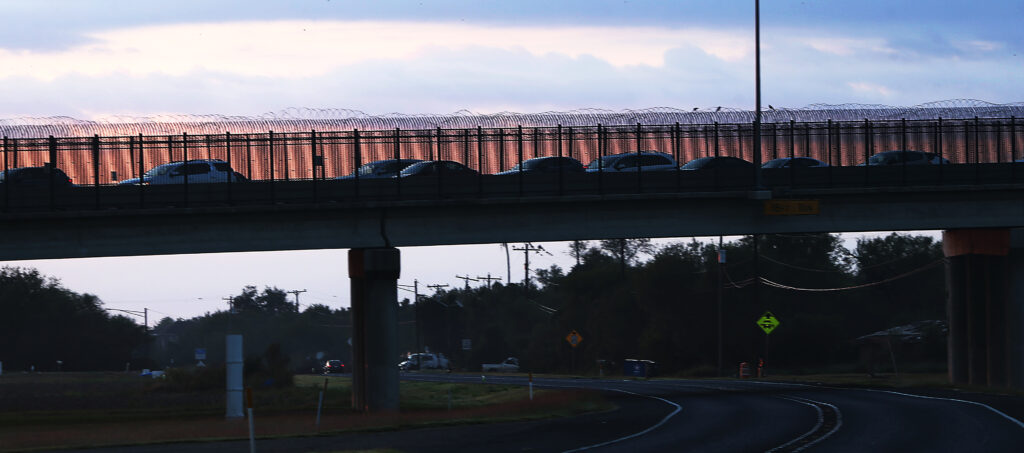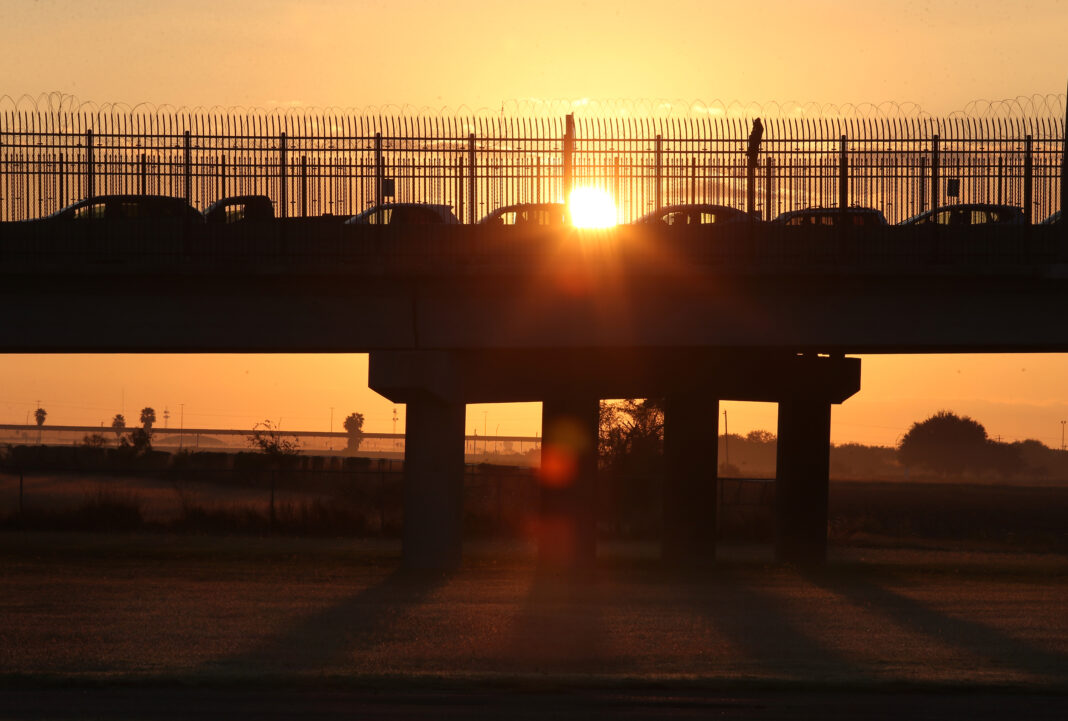The long wait is over.
International bridges opened Monday to vaccinated Mexican travelers considered “nonessential” for the first time in 20 months, or since the onset of the COVID-19 pandemic.

A pedestrian walks on the Hidalgo/McAllen International Bridge in Hidalgo, Texas on Monday, Nov. 8, 2021. On Monday, the U.S. reopened its border to fully vaccinated foreign travelers. The border had been closed to discretionary travel since March 2020. (Delcia Lopez/The Monitor | [email protected])
Nonessential — one might argue keeping family ties alive with a long embrace or sharing heartfelt laughs over a meal are necessary in a binational community, but the government left out such emotional considerations during a global, life-threatening event that closed borders across the world and in the U.S. since March 2020.
Long lines formed in Reynosa heading into the U.S. at midnight and took a few hours to clear. After the initial surge, drivers and pedestrians spent a short time in line, many said.
“There wasn’t a long line,” Victoria Garza, a mother who crossed with her 18-year-old son, said while at the Hidalgo-Reynosa International Bridge.
The pair stood under an umbrella they brought to shield them from the sun during the long wait times they anticipated.
“We expected more, but thank God there weren’t that many people in line,” Garza added.
They managed to get into the U.S. in 20 minutes. Garza came to see her 23-year-old son who is married and living in the Rio Grande Valley. The pandemic and subsequent policies kept them apart.
Over a year, families like hers kept in touch through small, cold and impersonal screens that made for strained intimacy. Even children felt the disconnect.
Betty Becerra, a 6-year-old who crossed at the Reynosa bridge with her mother, was excited to see her grandmother living in the Valley.
What did Betty miss most?

“She always hugs me a lot and she loves me a lot,” she said with unrehearsed frankness.
Another young girl crossed into the U.S. without her parents, an act that intimidated her. She was in the company of her older cousin and braved the trip without mom to get the vaccine, although children younger than 17 are not required to be vaccinated in order to enter the country.
“It didn’t hurt,” 11-year-old Natalia de Leon said as she rubbed her arm where the sharp needle had recently pierced through. “I felt really good. Nothing happened,” she insisted.
Many of the children crossed with mom and dad with bows in their hair, smiles on their faces, and in their Sunday best. Family visits were a priority.
While some counted the months to steal some time away with loved ones, others longed for a different kind of love.
“The first thing we came to do was to buy some hamburgers,” Jorge Leal, 44, said as he tenderly cradled a bag of Whataburger’s no. 1 combo. His teenage son smiled under his mask as he walked with his dad back toward the bridge. “We were craving this for over a year.”
The pair have relatives in Mission, but with the bridge now open, there will be time to visit with them later.
“We plan to come on the weekend, God-willing. This time to see our relatives in Mission, so they can prepare with food,” Leal joked.
“Come across, spend time with your child and come back — that’s an experience you took for granted before,” Juan Olaguibel said, reflecting on the seemingly mundane visit to a local restaurant. “Those are the little things that count.”

Traffic is seen backed up on the Anzalduas Bridge in the the early morning hours of Monday, Nov. 8, 2021 in Mission, Texas. On Monday, the U.S. reopened its border to fully vaccinated foreign travelers. The border has been closed to discretionary travel since March 2020.(Delcia Lopez/The Monitor | [email protected])
Olaguibel serves as McAllen’s superintendent of bridges. He was pleased to see an efficient management of the traveler’s time. He said Customs and Border Protection officers were preparing well in advance of the reopening and felt it proved fruitful Monday.
The fast queue gave many the impression that the crowds were small.
A taxi driver waiting in his cab noticed the slow pace, too, painfully so.
“I’ve been here since 11 a.m. and I haven’t gotten a ride,” Jose Rodriguez, from Pharr, said Monday around 2:30 p.m. He’s 73 years old and driving people around is his only form of employment.
In pre-pandemic times, Rodriguez averaged five to seven trips a day. When the bridges closed, he was lucky to get one. He stayed later into the night to try and snag a customer.
“Few people crossed over today, since it’s the first day. Maybe because not a lot of people have gotten vaccinated yet, and now they’ll do it,” Rodriguez said with some hope in his voice.
A bridge employee who preferred not to be identified said they didn’t notice a change in traffic, with the exception of the midnight rush. Olaguibel said he expected the total number of visits will be available Tuesday, when they’ll have a better understanding of the historic reopening.
Like a muscle in atrophy, visiting the border may need to become more frequent again before it makes a full recovery.

Traffic is seen backed up on the Anzalduas Bridge in the the early morning hours of Monday, Nov. 8, 2021 in Mission, Texas. On Monday, the U.S. reopened its border to fully vaccinated foreign travelers. The border had been closed to discretionary travel since March 2020.(Delcia Lopez/The Monitor | [email protected])




